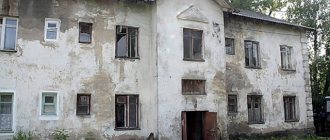To date, the area of uninhabitable housing in the country has exceeded 10 million square meters. The state has committed itself to demolishing dilapidated and dilapidated housing and relocating citizens to new, comfortable and safe homes.
It would seem that residents should only rejoice at such changes, but disputes and discontent occur, since many do not know the rules of the law and their rights. Let's talk about the intricacies of relocation from dilapidated and emergency housing and the rights of owners and tenants.
Rules of law
The law regulates the rights of residents of demolished buildings and the procedure for reforming the housing stock.
The legislative framework regulating the rules for the resettlement of citizens from unsuitable premises includes:
- Housing Code of the Russian Federation;
- Federal Law “On the Fund for Assistance to the Reform of Housing and Communal Services”;
- Government Resolution No. 47 of January 28, 2006 “On approval of the Regulations on recognizing premises as residential premises, residential premises unsuitable for habitation and an apartment building as unsafe and subject to demolition or reconstruction.”
Dilapidated housing
A building is considered dilapidated if it has worn out due to temporary changes. Stone and brick buildings are considered dilapidated when worn over 61%, wooden buildings - when worn over 65%. Although the supporting structures retain strength and ensure the stability of the building, the house no longer meets operational requirements.
The main difference between dilapidated housing and emergency housing is that the former is characterized by a high level of wear and tear on supporting structures without the danger of the entire building collapsing.
Emergency
When a building is in an emergency condition, more than 50% of residential premises and load-bearing structures (foundations, walls) are deformed and may collapse, putting the lives of the people inhabiting it in danger. The buildings have been damaged and have lost their strength. Such changes occur due to wear and tear or external factors (man-made accidents, errors during construction).
If the collapse of a wall or other structure of a house does not entail changes in the operation of the building and the living conditions of the residents, then the residential building is considered pre-crash and suitable for habitation.
Government program
The Federal Housing Program was developed in 2002. The goal of the program is to provide citizens living in houses unsuitable for habitation with more modern and safe buildings. The housing and communal services reform for resettlement from dilapidated housing was supposed to end in 2007, then in 2010. However, after the extension of the federal program, the resettlement procedure was not fully implemented. Since 2010, the program has been implemented taking into account the characteristics of the regions. The housing reform has been extended until January 1, 2019.
Ulyanovsk is a city of news ()
But if an apartment building is included in the list from the address program, the consent of the apartment owners is not required. According to the resolution of the city administration, if on the territory that is planned to be developed there is a building that is recognized as unsafe or subject to demolition, the Ulyanovsk administration makes a demand to the owners of apartments in such a building for its demolition or reconstruction. After this, the owners are sent a notification about the seizure of the land plot on which the house is located, and the residential premises themselves, for state or municipal needs. After this, the authorized body (the city property management committee) assesses the amount of compensation for the demolished housing and tries to negotiate with the owners either to pay compensation or to sign an agreement to provide another apartment. If the owner does not agree with the decision to seize or with the amount of compensation, then there is only one mechanism left - going to court.
The apartments will be seized for demolition
The winning developer of the auction prepares a project for planning the territory, carries out land surveying and undertakes to provide the city with apartments for the relocation of residents from houses subject to demolition. In this case, we are talking not only about apartment owners, but also about residents of non-privatized apartments who use them under social tenancy agreements. After this, the developer receives the right to register the land plot as ownership or lease for construction. At the same time, the city gives away the land absolutely free of charge.
c) the real estate property is not subject to restoration as a result of natural and man-made emergencies or restoration work is technically impossible or economically infeasible.
We recommend reading: Amount to Pensioners for Work Experience in the Territory Contaminated as a Result of the Teapot Accident
Recognition procedure
An old and potentially dangerous building for residents is recognized as unsafe or dilapidated based on an inspection by an interdepartmental commission or an application from citizens demanding that the buildings be recognized as such.
Reasons
Residential buildings are considered unsafe if:
- located in hazardous areas where avalanches, landslides, mudflows, and annual flooding with melt water occur;
- there is damage to the structure of the building due to accidents, explosions, earthquakes, fires, and soil subsidence.
At the same time, the restoration of buildings should be considered impossible due to inexpediency from the point of view of monetary investments and engineering intervention.
Work of the interdepartmental commission
The decision to recognize a building as unsafe or dilapidated is made by a specially created interdepartmental commission, which checks the compliance of the condition of the residential building with the requirements for the safety of living of residents. An interdepartmental commission is created by local executive bodies and with the participation of representatives of various government departments to assess the condition of a residential building.
The commission includes representatives:
- local executive body;
- Department of Emergency Situations;
- state architectural and construction control;
- housing inspection;
- sanitary and epidemiological control;
- consumer protection.
Application procedure
The owners of a dangerous house must collect documents to carry out the procedure for recognizing a residential building as unsafe and subject to demolition.
List of documents required to recognize housing as unsafe or dilapidated:
- an application requesting that the house be declared unfit for habitation;
- technical passport from the BTI indicating the degree of physical wear and tear of the house and its structures;
- certificate of inspection of the house by the fire service and Rospotrebnadzor;
- layout of the entire building and premises (issued by the BTI);
- conclusion on the technical condition of the house, structures, individual premises, indicating the degree of unsuitability of the apartment building;
- inspection reports of HOAs and housing inspections, reports on repair work carried out;
- conclusion of the city housing inspection on the measures taken to monitor compliance with housing legislation.
The procedure for demolishing dilapidated housing
Demolition of dilapidated housing is a complex procedure that includes several stages. One of which is the provision of alternative housing. Due to the large number of nuances and appeals to the court, for each citizen affected by this, the procedure results in a large number of questions.
Demolition of dilapidated housing
Most citizens prefer relocation, although the state allows the area to be sold to the municipality. But the second option is much more unprofitable, since the citizen will receive funds, but definitely in a smaller amount than the cost of new housing.
- After a decision is made to recognize a particular residential building as unfit for habitation, the relevant government agency must immediately notify citizens living in this house (within a reasonable time: at least a month in advance);
- If the residents did not respond to the warning about the emergency condition of the house (did not submit an application for demolition or did not ask for major repairs), the state has the right to demolish the house by alienating a specific building for the needs of the country;
- Having made a decision (usually it is made three months before demolition) to dismantle the structure, the state immediately begins the search for new, no less worse housing conditions for citizens;
- At this time, the process of dismantling the building is already underway (if not all people have found a “roof over their heads”, they can be moved to temporary housing at the expense of local authorities (hotel, hotel);
- That's it, the house is demolished and the people are resettled - the project is completed.
In more detail, it would not be out of place to note that the recognition of housing as dilapidated or dilapidated directly depends on paragraph 7 of the Regulations “On recognizing premises as residential, residential premises unsuitable for living in a multi-storey residential building as dilapidated or dilapidated .
Reasons
- None of all existing laws provides a complete and specific definition of the term “dilapidated housing”;
- According to the same legislative acts, housing is considered dilapidated if its wear and tear has exceeded 70%. At the same time, none of the relevant government structures has a standard formula based on which it was possible to determine the degree of deterioration of the building;
- When demolishing housing, residents must be resettled in apartments/rooms of a similar condition to the previous ones. Often, due to “holes” in the laws, citizens move to residential buildings with worse conditions than they had before. This causes a lot of litigation in which the citizen wins, but only after spending a lot of time, money and nerves on this matter.
Making a plan and schedule
Local authorities must draw up a plan for the demolition of dilapidated housing at least two years before the actual implementation.
During this time, local governments are obliged to:
- draw up a resettlement plan;
- build new houses for apartment owners;
- notify residents of the upcoming resettlement.
Citizens are notified within 5 days from the moment the decision is made by local authorities.
How to get information about a house
The local executive authority is obliged to notify citizens about the upcoming relocation. But often rumors get ahead of events, so residents are interested in the demolition plan in the locality and the order of their houses. This issue is covered on the portal of the local mayor's office and city council in the section “Plans for the resettlement of houses” or “Housing issues”. The list of houses declared unsafe and subject to resettlement is posted on the website “Housing and Communal Services Reform” https://www.reformagkh.ru/relocation/.
Demolition of Dilapidated and Unsafe Housing in Ulyanovsk 2020 Lists
All other groups of citizens who have chosen social rent will be required, in addition to utilities, to pay monthly rent - up to 70 percent of the market rental of residential premises. At the moment, investors have only been found for the development of four of the planned territories. Three years ago, 2 thousand people managed to get out of dilapidated two-story buildings, in 1 thousand. According to the mayor's office, investors are not showing interest in the plots due to the difficulties with resettling residents in dilapidated buildings, and also due to the fact that not all territories have investment attractiveness.
We recommend reading: Benefits for Honored Workers of the Omsk Region
Ulyanovsk houses for demolition 2020
To resolve controversial issues, federal legislation was undertaken to regulate the procedure for confiscation of residential premises from owners. Monetary compensation is not due to those who received an equivalent apartment or house in exchange for seized housing.
Novomalyklinsky municipal district 2 Novospassky municipal district 2 Pavlovsky municipal district 0 Radishchevsky municipal district 0 Sengileevsky municipal district 13 Starokulatkinsky municipal district 0 Staromainsky municipal district 0 Sursky municipal district 0 Terengulsky municipal district 0 Ulyanovsky municipal district 10 Tsilninsky municipal district 0 Cherdaklinsky municipal district 0.
Residents' rights
Legislation protects the rights of residents of private and apartment buildings during demolition. However, owners and tenants have different rights.
Owners
When relocating owners of dilapidated housing, the owner has the right to receive living space similar in size and number of rooms. In addition, the area must be provided in the same area or in the same locality.
The owner has the right to refuse relocation and receive an amount for the apartment equal to its market value.
Tenants
When moving into a dilapidated house, a tenant can count on the following:
- the new housing must correspond to the social norm for housing area per person;
- the apartment must be comfortable;
- housing must be located in the same locality;
- If several families live in a residential building, they may be given different apartments.
Who is entitled to compensation?
If housing belonging to the owner is alienated in favor of the state for the construction of more important objects, he is entitled to compensation, but only if the owner refuses the housing provided in return for good reasons. The owner writes a statement of refusal of the living space due to him and receives monetary compensation in the amount of the market value of the property.
Compensation is also due for associated costs of moving and transporting things. It is possible to reimburse the cost of a land plot if it is registered in the cadastral register, but in practice few people receive this money.
Right to increase area
The right to increase the area has a family living under a social contract in a living space that does not meet the standards of required square meters per person. For example, if a family of five lived in 40 square meters, then upon relocation they are entitled to 18 square meters per family member. The area norm differs in regions.
Temporary housing
Residents are sometimes provided with temporary housing. This happens if continued stay in the building is life-threatening or if citizens lose a roof over their heads due to natural disasters, fire or explosion. Citizens are resettled in housing from a specialized fund.
Temporary housing includes:
- residential premises from a flexible stock;
- service apartments;
- residential premises for temporary residence of refugees and internally displaced persons;
- housing intended for vulnerable segments of the population (orphans, disabled people, etc.).
When forced to relocate to apartments and rooms from the flexible stock, the size of the living space of the apartment where the displaced people previously lived is not taken into account.
Accommodation rules
The resettlement procedure is carried out in the manner and within the time frame approved by the municipality. Under no circumstances should the rights of residents be violated.
Notification
According to Article 32 of the Housing Code, residents of a dilapidated building are required to be notified of the results of the technical examination, the decision made and the timing of resettlement. Citizens receive the first notification by mail, and representatives of the administration bring the second one to their home for signing.
Information contained in the notice:
- estimated completion date for demolition and resettlement;
- the conditions under which new housing will be provided;
- procedure for registering property rights.
Solution
The final decision is made by an interdepartmental commission based on the conclusion of an independent expert commission on the condition of the building. The decision of the interdepartmental commission and the expert opinion are transferred to the municipality, which issues a decision on reconstruction or demolition.
Changes in the law
In recent years, significant changes have been made to legal acts on the issue of resettlement. In particular, the housing presented to the owners has a higher price than the one that was alienated. Previously, owners were required to pay 13% of the difference in the cost of new housing from the old one. According to recent news, the Ministry of Finance has eliminated this requirement.
Preferential categories of citizens
In rare cases, the state provides tenants with free financial assistance - a housing subsidy for the construction or purchase of their own house or apartment.
This takes into account the number of citizens living in municipal housing.
It is possible to resettle citizens from municipal apartments to new ones provided on the basis of free ownership in relation to the following categories:
- WWII veterans;
- military personnel;
- employees of internal affairs bodies;
- combatants;
- employees of departmental and law enforcement agencies;
- low-income citizens and their families;
- judges.
Regional experience
At the moment, according to reports, 58 regions of the Russian Federation have completed the resettlement program and 8 regions are completing the process. Each of the subjects adheres to the basic legislative acts of the state on housing issues and at the same time has its own special approaches.
Renovation in the capital
In Moscow, dilapidated housing includes:
- buildings with deformed foundations;
- premises located in the danger zone of landslides and other natural phenomena;
- houses in which structures were damaged as a result of emergency incidents;
- houses located in areas of possible man-made disasters.
In the capital, typical five-story buildings, which in other cities are not considered unsafe, are eligible for resettlement. “Khrushchev buildings” occupy vast territories and look unpresentable for the capital.
Other regions
Different regions and regions have their own peculiarities in implementing the resettlement program.
In Sochi, apartments were put up for competition and purchased from the winning developer. In Makhachkala, when determining the amount of compensation, the administration takes into account the cost of the premises on the real estate market and the funds spent on relocation. In St. Petersburg, comfortable housing is provided from the city fund.
The “Dilapidated Housing” program also operates in rural areas. The procedure is financed from the budget of the rural settlement, as well as from raised funds.
Relocation from emergency housing after 2020
In order to reduce the housing stock unsuitable for habitation, the “Dilapidated Housing” program was developed. It started in 2002, but it is too early to talk about the deadline for implementation - a significant number of objects do not meet safety requirements. In accordance with Presidential Decree No. 204 of 05/07/18, resettlement from emergency housing will continue after 2020. By July 20, 2020, new mechanisms will be developed and legislated.
Program conditions
The tightening of conditions is due to the need to stop abuses. They are associated with the acquisition of an emergency object “for pennies” with the subsequent receipt of expensive, comfortable real estate. The need to invest money makes such a scheme unprofitable, but at the same time it allows people in real need to get an apartment on favorable terms (they do not have to apply for a mortgage loan to the bank). Otherwise, the rules for implementing the program remain the same. In accordance with the passport of the national project, in 2020, 1 million square meters will be resettled, about 55.8 thousand people will receive new apartments. Despite the impressive figures, the pace of resettlement will exceed the volume of emergency real estate by 30% only in 2023.
It happens that this money is not enough to buy a new home because the house being demolished was small or dilapidated. In the second case, the process of searching for equivalent housing may take years, because it is difficult to find exactly the same housing in the same area and near the same structures, hospitals, schools.
What problems arise
The resettlement of citizens is often accompanied by controversial situations. Some owners of good-quality buildings refuse to move when relocating to an area in which most private homes are unsuitable. In this case, the law is on the side of the owner, since the home is inviolable, and the citizen is the owner. On the other hand, if there is only one house left in a block, the state cannot build new buildings on this territory. Litigation in such cases lasts for many years.
A citizen who refuses to leave an emergency living space may be forcibly evicted.
Disputes also arise when the rights of tenants are violated:
- alternative housing is smaller in area than the previous one;
- the redemption amount is much lower than the market price.
In such cases, citizens can go to court.
How is demolition done?
Dismantling of the construction site is carried out after the residents of emergency housing have been relocated and all legal issues have been resolved. Before dismantling, design documentation is drawn up. The issue of waste removal and disposal is important. They cannot be sold. If a house in the private sector is destroyed, then usually the neighbors begin to sort out the construction waste brick by brick. There is no direct violation in this, but the remains of the building may collapse, so the removal of construction waste will be organized as soon as possible.
Legal advice
Our family is offered secondary housing for resettlement. Is this legal?
If the city does not have a new home to resettle citizens from the demolished area, then they may be offered secondary housing. However, secondary housing should not be older than 1980, meet all sanitary and regulatory requirements, be well-equipped, and the area should not be less than that of the damaged house. One of the advantages is that such houses are located in the center of large cities, and new buildings are built on the outskirts. If you do not want this, you can file a claim to protect your rights in the district court.
Lawyer
Previously, our family lived in a three-room apartment with a total area of 58 m2. According to the resettlement program, they provide an apartment with fewer rooms and an area of 72 m2. Can you count on a three-room apartment in a new building?
When moving in, the area in the previously occupied apartment is taken into account. The number of rooms is not considered. If a tenant does not like the apartment offered for resettlement, he can refuse it and receive a redemption price equal to the market value. In this case, the benefits of moving to a new house with a larger area are obvious.
Lawyer
Where can I find out about the timing of the demolition of a house in Ulyanovsk
The section “Emergency Housing Stock” provides information on emergency houses that are subject to resettlement. The “House Quality Control” section presents built houses for which there are complaints indicating specific deficiencies in the quality of residential premises. The “Resettlement Contracts” section presents concluded contracts for the resettlement of citizens from dilapidated housing, including: contracts for the construction of apartment buildings, participation in shared construction, purchase of premises from the developer, purchase of premises on the secondary market, purchase of premises from the owners, as well as other contracts . The section “Houses under construction” presents a list of houses under construction under programs for relocating citizens from emergency housing. The “Houses Built” section presents a list of houses built under programs for relocating citizens from emergency housing. The “Rank of Subjects” section presents the rating of subjects for the implementation of programs for relocating citizens from dilapidated housing stock, as well as the final indicator of program implementation.
Where and how can I find out when my house will be demolished?
Kuzovatovsky municipal district. Mainsky municipal district. Melekessky municipal district. Nikolaevsky municipal district. Novomalyklinsky municipal district. Novospassky municipal district. Pavlovsky municipal district. Radishchevsky municipal district. Sengileevsky municipal district. Starokulatkinsky municipal district. Staromainsky municipal district.
- the structure was deformed, which resulted in the formation of cracks;
- no water, gas or electricity for one month without good reason;
- the presence of an unpleasant sewer odor after attempts to repair ventilation;
- extreme humidity, which leads to the development of fungus;
- the building is located in the basement;
- there are no windows or the amount of light received does not meet the standards;
- the presence of toxins with an exceeding dose.
We recommend reading: Benefits for Pregnancy and Childbirth in the Region in 2020







